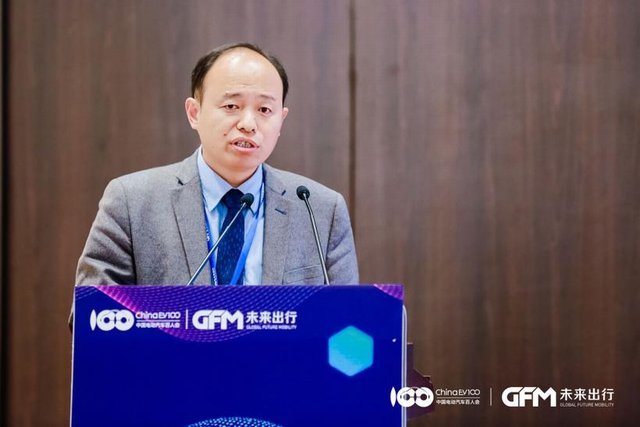2019 Global Future Travel Conference | Guo Yingjun, Chairman of Xianghe Kunlun Chemical Co., Ltd.: Research progress and theoretical innovation of new electrolytes
2020-10-30 17:12
In order to better promote global cross-border collaboration, clarify the roles of travel companies, car companies, cities and other entities in the future travel ecology, and discuss major changes in future travel modes, travel technologies, transportation structures, and transportation strategies. As well as the opportunities and challenges that the entire industry will face, the China Electric Vehicle 100 Association will organize the 2019 Global Future Mobility Conference to promote ecological transformation, transformation and innovation and international collaboration, and embrace the mobility revolution. The following is a transcript of the speech of Guo Yingjun, Chairman of Xianghe Kunlun Chemical Co., Ltd.:
Good afternoon, all friends from the industry, I haven’t given a speech on stage for a long time. Our Xianghe Kunlun Chemical Co., Ltd. makes electrolytes. We also mentioned that we built a new factory in Huzhou at that time, in order to cooperate with customers in Jiangsu, Zhejiang or the south. Industrial support, the company has been focusing on the development of lithium battery electrolytes since its establishment 15 years ago.

Below I will give you a work report from these aspects. The first is the theoretical innovation research on the electrolyte, which is mainly based on the theoretical innovation made by the researchers of the Great Wall Liquefaction Institute and the actual research and development situation of our company. It is generally believed that the operating mechanism of the current theoretical basis of the electrolyte is the SEI film. There are many articles behind the actual SEI film. The starting point of our theoretical basis is to push the SEI film theory forward, or a breakthrough theory. The liquid bulk lithium ion solvent, additives and other newly added molecules, their solvation and their interactions have a profound impact on the performance of the SEI film and subsequent cycles, not only the surface of the SEI film that everyone sees. condition. This is a cycle with different solvents. The SEI film is initially formed in the cycle. After the SEI film is formed, it is disassembled and then replaced with a different electrolyte. Its subsequent cycle is completely different. The upper left corner is carbonates, black is the SEI film formation process, red is circulation, and carbonates can form a relatively good SEI film. The picture D is ethers. If the solubility is low, it is difficult to form. If the electrolyte concentration is increased, from 0.4 to 2.5, the cycle can be stably circulated. After dismantling, the ester solvent can be changed. A series of models. Compared with the SEI membrane electrolyte, lithium ion solvation plays a more important role. Our preliminary conclusion of the SEI film, at present, we believe that it only plays a leading role in the co-migration of the solvation of lithium ions, and the subsequent impact is not as large as we imagined. This is a surface model made by SEI film theory. The voltage on the surface of lithium carbonate is relatively high. We believe that it has no SEI film, and the graphite surface will form the relatively complex composition and structure of the SEI film shown in the figure above. This is because of the potential of the graphite negative electrode, the entire solvent will undergo electrochemical reduction on the surface. Why does lithium carbonate have a long cycle life, it does not form the repeated reaction of the SEI film, and consumes it, which is relatively stable. Graphite is constantly forming a reaction. Maybe after the SEI film is stabilized, this reaction is very small, although it is small. After the SEI film is damaged to a certain extent, many side reactions will be formed, and in the end, the battery will collapse.
This is a theoretical model. We study the cathode material. The electrolyte material is a solvent unit, and the electrolyte composition is a salt + dispersant composition, which is similar to our cathode material. That is to say, our theory takes the traditional SEI membrane theory one step further, because now everyone is doing electrolyte research, which has become a kind of empiricism. The electrolyte formula is similar to the prescription of traditional Chinese medicine. There is no way to quantify how much to add. Based on experience and feeling, it is completely unable to meet the needs of our power battery and other high-energy-density batteries for electrolyte development. We urgently need to innovate a new theory to guide our research and development. and recipe design.
There is a problem here. After the lithium ion forms the ligand, the interaction between the solvent and the ligand, and whether it has any effect on the reducing ability of the solvent itself, and how much does it affect, this is what we need to consider. For example, it is over to compare the structure of this electrolyte to a positive electrode material.
We have taken out the very important constituent additives of the electrolyte. Now the additive content is generally expressed as a percentage, 1%, 2%, 3% or 0%. In fact, we can change it from a different angle. After the number of moles, if the first VC is 5% by volume, it is equivalent to 7.8 molar concentration, which is relatively high. Compared with 2% VC, its concentration is equivalent to 0.31 moles. After converting to molar concentration, everyone may have a more intuitive understanding of the composition of the electrolyte, but the original percentage has no idea what it is. proportion. In this way, the relationship between lithium ions, solvents, and additives is relatively more vividly represented, because we just said that we have solvents and additives around lithium ions one by one, and we build models according to numbers and quantities. We convert this additive into moles, which is more scientific and intuitive. I just said that the actual amount of additives added is higher than we thought.
The role of the electrolyte additive is generally as a film-forming additive. We are now further studying that the additive plays a good role in the solvation and coordination of lithium ions in the electrolyte. The two figures on the right are mainly DTD-containing and DTD-free additives, because DTD is a relatively strong solvated additive, and it has a relatively impact on the entire cycle. Now DTD is a new type of additive in full swing. The role of SEI is to reduce surface side reactions by reducing the electron conductivity at the interface through membrane steric hindrance. It does not help to prevent the co-intercalation of lithium solvents. The additives are not only limited to film formation, but also bring about changes in solvation.
This is the role of the electrolyte or the additive. A series of electrolyte systems are built to establish a model between lithium ions, solvent molecules and additives. According to the first picture below, it is pure PC. Gradually adding 6V lithium phosphate and DTD will cause the Significantly changing the capacity of the electrolyte, this solvent structure will affect the SEI film and thus affect the performance of the battery. This theory is a bit more complicated. Let me briefly explain it to you first.
This is the desolvation model of the interface electrolyte desolvation model at the electrode interface. The solvated molecules around the lithium ions are contained, gradually approaching the top surface, and then the desolvation process is carried out, and then finally the lithium ions are contained. Abandon the solvated molecular binding protection and enter the electrode. The following picture means that the whole is entering the frame, and the B value refers to the way and tightness between the various solvent molecules of lithium ions. The main points of the model ABC is the solvation process of the solvent unit, L in D is the strength of the interaction between lithium ions and the solvent, and the B value is the steric hindrance effect of the negative electrode surface space.
Our conclusion is again about the role of additives.
Next, let's talk about the innovation of our company's actual products in electrolytes. We are developing various common battery systems, with different cathode materials, anode materials, different energy densities, and different voltages. The upper left corner is the customer's mass production data, customer test data, cycle and high temperature performance are very good. On the right is the cylindrical battery, which has a clear performance advantage. This is our own and domestic first-class aluminum shell supply battery company, the electrolyte formula, we have improved its formula in terms of performance and cost, our electrolyte system is not about tinkering, we have made a new design according to the research and development theory , it can be seen that most of its performance is better than its original performance in all aspects, and the cost is also low. I did not put the cost comparison on it, and the cost is about 18% lower than it. This is the circulation system of 811 to artificial graphite. I am talking about this, this is the 811 positive electrode to silicon carbon negative electrode soft pack battery that we cooperate with customers to open. This is a newly developed electrolyte system without EC. We mainly use button batteries for evaluation. From the above data, the electrolyte without EC is still very promising. Next, we will do it in the actual soft pack battery. Extensive testing, this is an EC-free electrolyte.
Briefly introduce our company. We have been in Xianghe and Huzhou for 15 years. Some of the mainstream battery companies in China are already working and some are in development. This is the instrument we tested, all of which are first-class brands, most of which are foreign. Our quality control can fully meet the requirements of any domestic manufacturer, including the audit of foreign companies. This is our R&D center in Xianghe factory. Equipment, we make our own soft-pack batteries and test the electrolyte. Not only do we test the electrolyte formula, but we are also studying various systems of battery positive and negative materials, and we have trained our talents, engineers, and sales teams. understanding.
This is the development plan of our company. The first liquid electrolyte still has great potential to be tapped. If there is a breakthrough in theory, I think it is still very promising to double or triple the amount of electrolyte. We cannot give up liquid electrolyte. We have already been doing research on solid electrolytes, and we have invited Japanese experts. This is a relatively advanced technology in Japan, and it is also relatively popular in China. But it is still mainly liquid, and the solid state will be longer. In addition, we have made arrangements for the important lithium salt additives. thank you all!
Relevant news
COPYRIGHT Xianghe Kunlun New Energy Materials Co., LTD Powered by 300.cn  冀公网安备 13102402000399号 TagList
冀公网安备 13102402000399号 TagList




